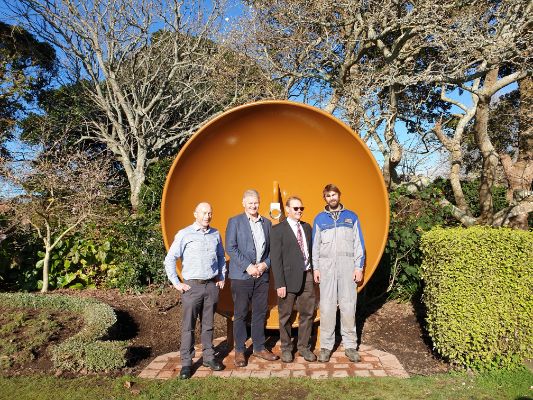New Attraction At Park Breaks Sound Barrier
If you go down to King Edward Park today, you’d better not go alone. Not because there’s a teddy bear’s picnic, but because two giant sound mirrors, donated by local business Global Stainless, have been installed and you’ll want to try them out.
Likely the largest sound mirrors in New Zealand, these massive dishes stand over two and a half metres high. Facing each other over a distance of 50 metres the sound mirrors enable a person to whisper into the focal point of one dish while a friend can hear the whisper at the focal point of the other dish.
“We are very grateful to Global Stainless Artworks for donating these wonderful pieces, and to the funders who made installation possible,” says South Taranaki Mayor Phil Nixon. “They will be a fascinating addition to our award winning Park. They are a little bit of art, a little bit of fun and a whole lot of science combined.”
Global Stainless Artworks Hāwera, fabricators of high end stainless steel balls, spheres and sculptures have worked with the South Taranaki District Council to provide the structures for the District. They make custom made products based on designs by national and international sculptors and artisans and sell all around the world.

Kerry Fowler from Global Stainless Artworks explains, “The parabola shaped dishes collect focus and amplify wave signals. Sound that originates at the focal point will bounce off the dish and travel in the direction the dish is pointing. The two dishes have been perfectly aligned so that when you speak into the focal point ring the sound bounces off the dish and collects at the dish on the opposite side of the lake. If you speak where the focal point ring is, your ears will also be in the perfect position for listening.”
Sound mirrors are sometimes called “whisper dishes”, “acoustic mirrors” or “listening ears”. They were a forerunner of radar and were built on the south and northeast coasts of England between 1916 and the 1930s. The mirrors were designed to detect enemy aircraft and airships as they approached the coast. The listener could determine the direction of the aircraft and provide advanced warning to the local people. By the early 1940s the technology was replaced by radar.
Te Hāwera Community Board chair Wayne Bigham says “the Board was delighted to help fund such a worthwhile attraction which will provide entertainment and a sense of wonder to our park visitors.”
Donations towards the installation of these sound mirrors were received from Te Hāwera Community Board, Lysaght Watt Trust, Fred and Eunice Rodie Trust, Pelorus Trust and Bizlink Hāwera.


 Gordon Campbell: On Why We Can’t Survive Two More Years Of This
Gordon Campbell: On Why We Can’t Survive Two More Years Of This Interchurch Bioethics Council: Church Bioethics Agencies Express Dismay at the Rushed Consultation Period for Submissions on the Gene Technology Bill
Interchurch Bioethics Council: Church Bioethics Agencies Express Dismay at the Rushed Consultation Period for Submissions on the Gene Technology Bill New Zealand Police: More Than $2.5m Worth Of Assets Restrained In Undeclared Tobacco Case
New Zealand Police: More Than $2.5m Worth Of Assets Restrained In Undeclared Tobacco Case SPCA: Survey Shows Government Lacks Mandate To Repeal Live Export Ban
SPCA: Survey Shows Government Lacks Mandate To Repeal Live Export Ban Peace Action Ōtautahi: Bridge Of Remembrance Peace Protest
Peace Action Ōtautahi: Bridge Of Remembrance Peace Protest National Wetland Trust: Public Asked To Help Prevent Fires In Wetlands This Summer
National Wetland Trust: Public Asked To Help Prevent Fires In Wetlands This Summer Lillian Hanly, RNZ: The Year In Politics - Stories That Dominated The Headlines In 2024
Lillian Hanly, RNZ: The Year In Politics - Stories That Dominated The Headlines In 2024


